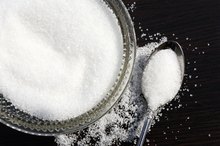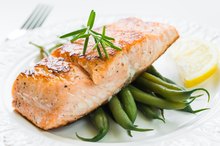What does fact checked mean?
At Healthfully, we strive to deliver objective content that is accurate and up-to-date. Our team periodically reviews articles in order to ensure content quality. The sources cited below consist of evidence from peer-reviewed journals, prominent medical organizations, academic associations, and government data.
The information contained on this site is for informational purposes only, and should not be used as a substitute for the advice of a professional health care provider. Please check with the appropriate physician regarding health questions and concerns. Although we strive to deliver accurate and up-to-date information, no guarantee to that effect is made.
The 1500 calorie ADA (American Diabetic Association) diet is designed primarily for those individuals who are overweight and suffering from diabetes 1. It is a low calorie diet that includes a certain number of carbohydrate exchanges that can be eaten in a day, depending on the person. The purpose of the 1500 calorie ADA diet is to promote weight loss or maintenance while at the same time reducing blood sugar levels in order to prevent complications that may result from unmanaged diabetes such as neuropathy and blindness.
Limiting Sugar Intake
People living with diabetes have a high amount of sugar in their blood. When the amount of sugar in someone’s blood increases or decreases drastically, the person becomes at risk for serious health complications. In order to keep their blood sugar from becoming too high, diabetics must limit their sugar intake. They should eat sweets such as cakes, cookies, pies and candy only rarely, if ever. There are sugar-free versions of many sweets that still have carbohydrates but do not raise blood sugar as high as the regular versions do. There is room for the occasional dessert on the 1500 calorie ADA diet, but it needs to be infrequent, planned and in a small portion.
- People living with diabetes have a high amount of sugar in their blood.
- There are sugar-free versions of many sweets that still have carbohydrates but do not raise blood sugar as high as the regular versions do.
Counting Carbohydrates or Exchanges
Can Diabetics Eat Rye Bread & Pumpernickel Bread?
Learn More
In the 1500 calorie ADA diet, calories, as well as carbohydrates are counted or estimated. Calories are limited to 1500 per day and carbohydrates are limited to about 45 to 65 percent of calories in the diet, which would be about 169g to 244g per day, but no more. You can either count grams of carbohydrates or exchanges instead, which is a way to estimate carbohydrate servings, similar to a points system. Ask your doctor or dietitian for an exchange list of foods or find an exchange list online.
- In the 1500 calorie ADA diet, calories, as well as carbohydrates are counted or estimated.
- You can either count grams of carbohydrates or exchanges instead, which is a way to estimate carbohydrate servings, similar to a points system.
Eating Protein Foods Often
Protein helps stabilize blood sugar and promote energy in diabetics so it should be eaten often on the 1500 calorie ADA diet. Some protein, even if it is only a small amount, should be eaten with every meal and every snack on this diet to offset some of the effects of consuming carbohydrates. Foods that are rich in protein include meats such as beef, turkey, chicken, pork and seafood. Soy foods, tofu, beans, nuts, peanut butter, lentils, cheese, cottage cheese and protein shakes are also high protein foods.
- Protein helps stabilize blood sugar and promote energy in diabetics so it should be eaten often on the 1500 calorie ADA diet.
Snacking Often
How to Lose Weight With Hypoglycemia
Learn More
Even though the 1500 calorie ADA diet is a fairly low calorie diet, it is still important to snack often. Skipping meals or going hours without eating something can make a diabetic weak and can be dangerous for a person’s blood sugar. Protein foods should be eaten every two to three hours even if it is only a small meal such as an apple and a string cheese. Consistency is important in meal times and snacking so meals and snacks should be eaten at around the same times each day to maintain blood sugar stability.
- Even though the 1500 calorie ADA diet is a fairly low calorie diet, it is still important to snack often.
- Protein foods should be eaten every two to three hours even if it is only a small meal such as an apple and a string cheese.
Limiting Fats
Being overweight or obese not only increases the chances that a person will develop diabetes, but it also worsens the symptoms and complications from diabetes for people who already have the condition. Therefore, on the 1500 calorie ADA diet, intake of dietary fats is limited in order to decrease calories and help promote weight loss. Even though foods such as beef and chicken are high in protein, the lean versions, such as lean beef and skinless chicken breast should be chosen over dark meat and higher fat options.
Related Articles
References
- Diabetic Diet: Medline Plus
- Mayo Clinic: Create Your Healthy-Eating Plan
- Giugliano D, Maiorino MI, Bellastella G, Esposito K. More sugar? No, thank you! The elusive nature of low carbohydrate diets. Endocrine. 2018;61(3):383-387. doi:10.1007/s12020-018-1580-x
- DiNicolantonio JJ, Lucan SC, O'Keefe JH. The evidence for saturated fat and for sugar related to coronary heart disease. Prog Cardiovasc Dis. 2016;58(5):464-472. doi:10.1016/j.pcad.2015.11.006
- Stanhope KL. Sugar consumption, metabolic disease and obesity: the state of the controversy. Crit Rev Clin Lab Sci. 2016;53(1):52-67. doi:10.3109/10408363.2015.1084990
- Khan TA, Sievenpiper JL. Controversies about sugars: results from systematic reviews and meta-analyses on obesity, cardiometabolic disease and diabetes. Eur J Nutr. 2016;55(Suppl 2):25-43. doi:10.1007/s00394-016-1345-3
- American Heart Association. The facts on fats: 50 years of American Heart Association dietary fats recommendations. Updated June 2015.
- La Berge AF. How the ideology of low fat conquered America. J Hist Med Allied Sci. 2008;63(2):139-77. doi:10.1093/jhmas/jrn001
- Kuzma JN, Schmidt KA, Kratz M. Prevention of metabolic diseases: fruits (including fruit sugars) vs. vegetables. Curr Opin Clin Nutr Metab Care. 2017;20(4):286–293. doi:10.1097/MCO.0000000000000378
- Clemente A, Olias R. Beneficial effects of legumes in gut health. Curr Opin Food Sci. 2017;14:32-36. doi:10.1016/j.cofs.2017.01.005
- U.S. National Library of Medicine, MedlinePlus. Omega-3 fats - Good for your heart. Updated January 13, 2020.
- Westerterp-Plantenga MS, Lemmens SG, Westerterp KR. Dietary protein - its role in satiety, energetics, weight loss and health. Br J Nutr. 2012;108 Suppl 2:S105–S112. doi:10.1017/S0007114512002589
- Choudhury H, Pandey M, Hua CK, et al. An update on natural compounds in the remedy of diabetes mellitus: a systematic review. J Tradit Complement Med. 2017;8(3):361–376. doi:10.1016/j.jtcme.2017.08.012
- University of California, San Francisco, Diabetes Education Online. Diabetes and alcohol.
- Satija A, Bhupathiraju SN, Rimm EB, et al. Plant-based dietary patterns and incidence of type 2 diabetes in US men and women: results from three prospective cohort studies. PLoS Med. 2016;13(6):e1002039. doi:10.1371/journal.pmed.1002039
- United States Department of Agriculture, ChooseMyPlate. Choose a food group to explore.
- U.S. Department of Health and Human Services, U.S. Department of Agriculture. 2015–2020 Dietary Guidelines for Americans. 8th ed. December 2015.
- Kastorini CM, Milionis HJ, Esposito K, Giugliano D, Goudevenos JA, Panagiotakos DB. The effect of Mediterranean diet on metabolic syndrome and its components: a meta-analysis of 50 studies and 534,906 individuals. J Am Coll Cardiol. 2011;57(11):1299–1313. doi:10.1016/j.jacc.2010.09.073
- Welsh JA, Sharma A, Abramson JL, Vaccarino V, Gillespie C, Vos MB. Caloric sweetener consumption and dyslipidemia among US adults. JAMA. 2010;303(15):1490-1497. doi:10.1001/jama.2010.449
Writer Bio
Sarah Davis has worked in nutrition in the clinical setting and currently works as a licensed Realtor in California. Davis began writing about nutrition in 2006 and had two chapters published in "The Grocery Store Diet" book in 2009. She enjoys writing about nutrition and real estate and managing her website, RealtorSD.com. She earned her bachelor's degree in nutrition from San Diego State University.









